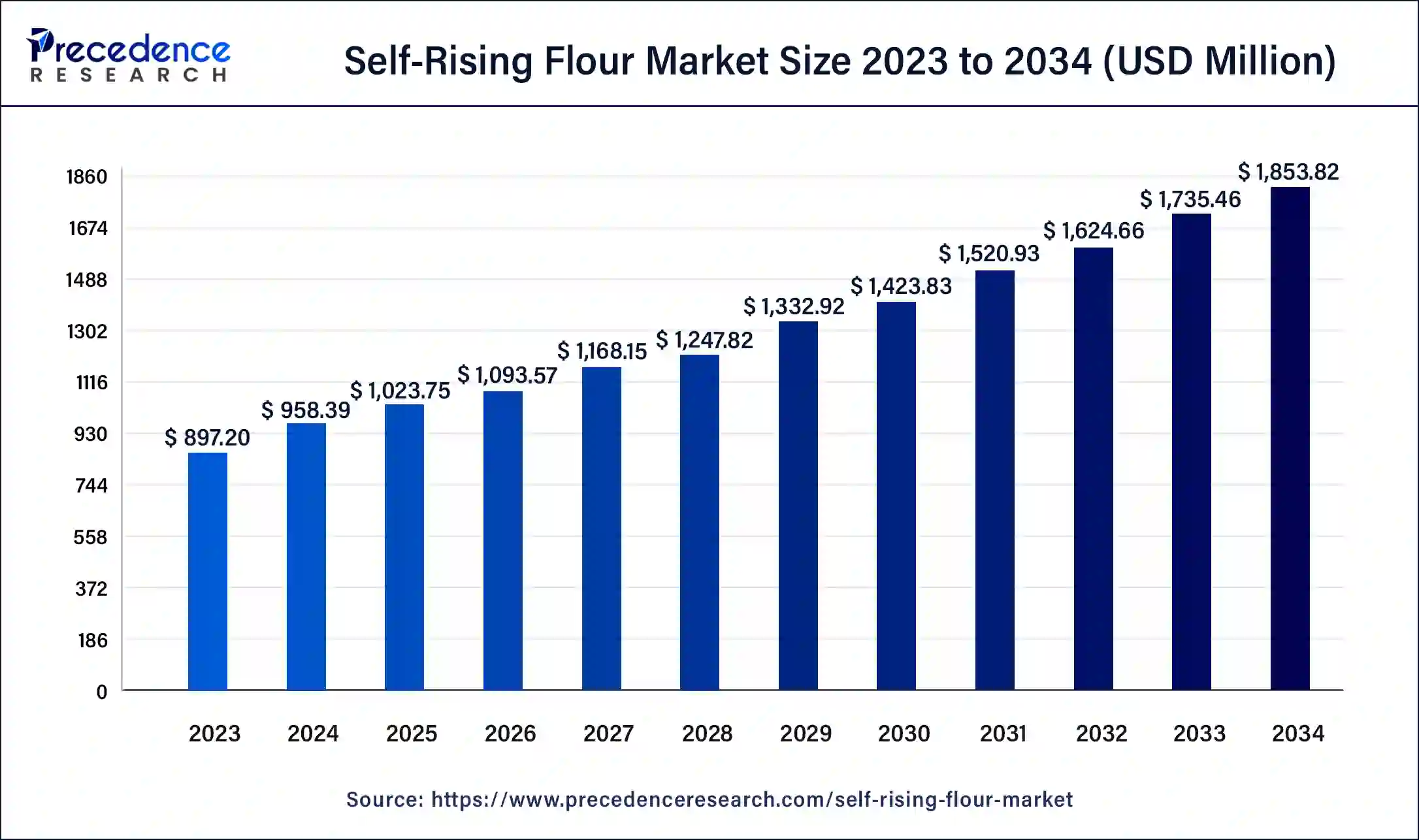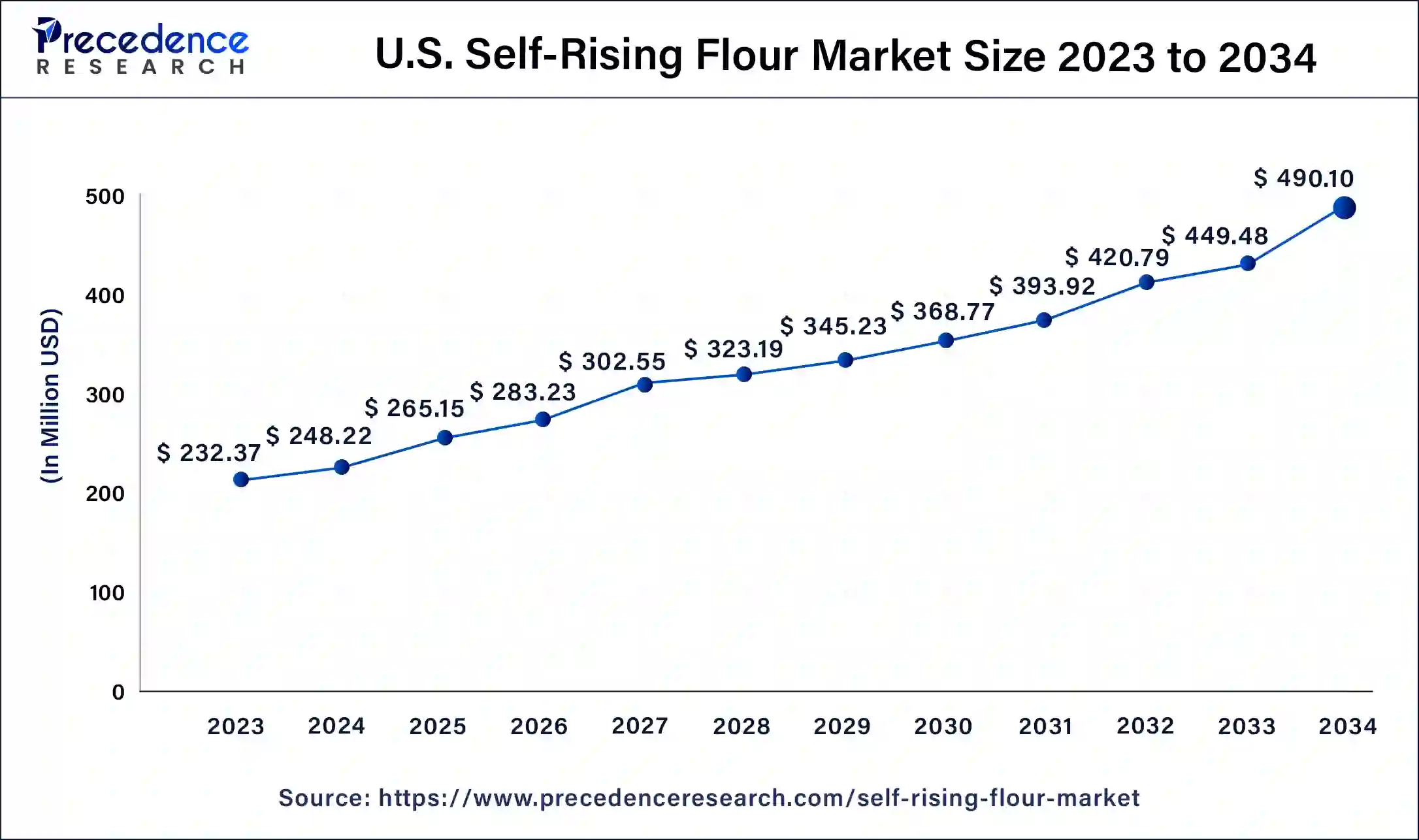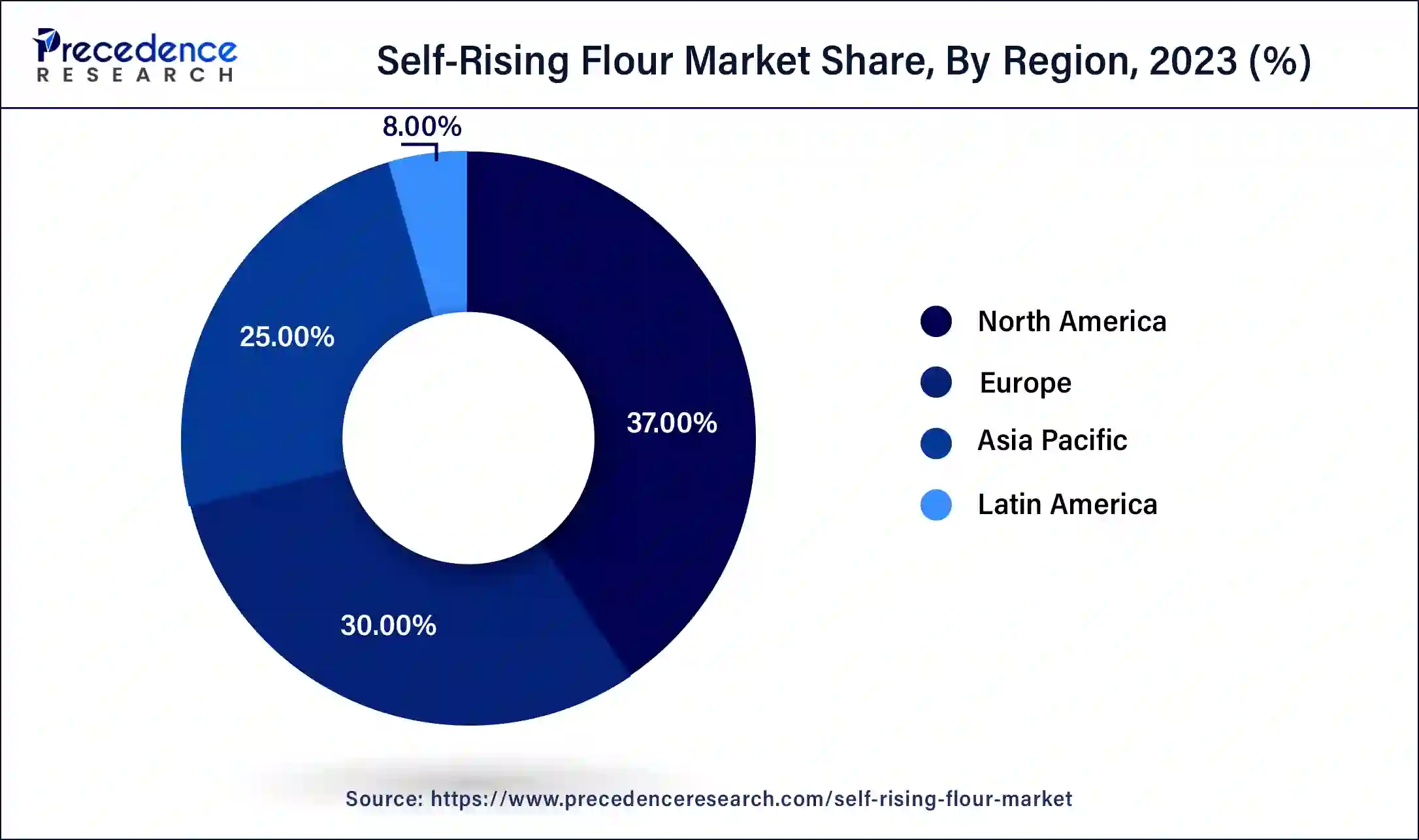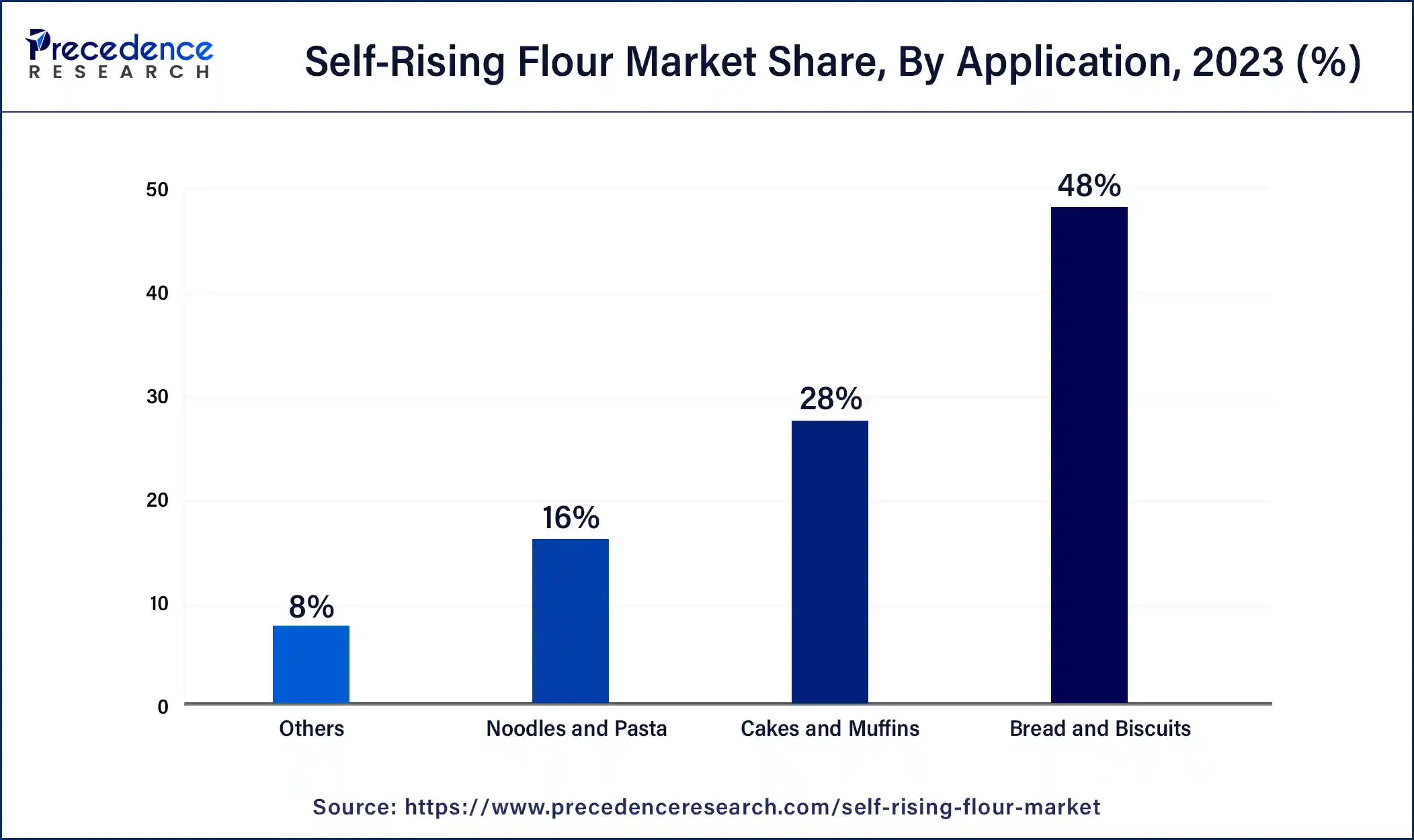December 2024
The global self-rising flour market size was USD 897.20 million in 2023, calculated at USD 958.39 million in 2024 and is expected to be worth around USD 1,853.82 million by 2034. The market is slated to expand at 6.82% CAGR from 2024 to 2034.
The global self-rising flour market size is worth around USD 958.39 million in 2024 and is anticipated to reach around USD 1,853.82 million by 2034, growing at a CAGR of 6.82% over the forecast period 2024 to 2034. The North America self-rising flour market size reached USD 331.96 million in 2023. The rising demand to consume softer, lighter, and tender baked goods contributes to the self- rising flour market.

The U.S. self-rising flour market size was exhibited at USD 232.37 million in 2023 and is projected to be worth around USD 490.10 million by 2034, poised to grow at a CAGR of 7.01% from 2024 to 2034.

North America dominated the self-rising flour market in 2023. The rising demand for organic, gluten-free flour and specialty flour is increasing the market growth in North America. Better weather conditions in the United States and Canada, two of the world's biggest wheat producers, have resulted in lower plantings but higher yields.

Asia Pacific will grow at the fastest rate in the self-rising flour market during the forecast period. The increase in production and consumption is experienced due to the rising population and increasing demand for what-based products. China and India are the leading countries in this region.
The self-rising flour market simplifies the baking process to prepare perfect, fluffy baked goods as it includes the leavening agent and the right amount of salt; no additional yeast or rising agents are needed. This is a convenient way to do this when baking supplies are lacking. Many self-rising flours are produced from bleach and low-protein soft wheat flour, which provides a soft texture and tender feel. Common recipes made from self-rising flours are cakes, biscuits, cobblers, pizza dough, bread, waffles, corn dogs, and many more. Self-rising flour is typically used in Southern recipes. The only difference between self-rising flour in the U.S. and the UK is that the flour in the United States has less baking powder and salt.
How is Artificial Intelligence (AI) Changing the Self-Rising Flour Market?
The incorporation of AI-powered tools facilitates the self-rising flour market and infiltration for bakers. It allows the user to invent new recipes and offers personalized advice. The personalized recipes are designed based on dietary recommendations and preferred flavors and tastes. It helps you generate a recipe based on available ingredients. It also customizes user recipes according to dietary restrictions and provides alternatives for allergy-causing food. AI suggests alternatives for not available ingredients. AI calculates the cooking time so the user can manage the time. Overall, it helps in transforming the baking experience by acting as a personal assistant.
| Report Coverage | Details |
| Market Size by 2034 | USD 1,853.82 Million |
| Market Size in 2024 | USD 958.39 Million |
| Market Growth Rate from 2024 to 2034 | CAGR of 6.82% |
| Largest Market | North America |
| Base Year | 2023 |
| Forecast Period | 2024 to 2034 |
| Segments Covered | Type, Application, Distribution, and Regions |
| Regions Covered | North America, Europe, Asia-Pacific, Latin America and Middle East & Africa |
Consistency and convenience
Self-rising flour is the most convenient flour among all the other used for baking goods as it already contains baking powder and salt. It raises the dough with any additional requirement of yeast or any other leavening agent. The result is always the same, as there is no manual need to measure the flour according to the ratio of different ingredients. A consistent light and tender result with each baked good is experienced.
Self-rising flour is ideal for beginner learners and for someone who has a short time in their hand to prepare. Self-rising flour provides a structural setting for cakes, pastries, and other baked goods, it offers extra leavening due to the presence of baking soda, which contributes to CO2 production and adds an appetizing flavour.
Property deterioration over time
Prolonged periods of storage enable the self-rising flour to lose its property. Self-rising flour has a limited shelf life due to the baking powder present in it. After the baking powder has expired, it becomes inactive, and the baked goods do not rise. The shelf life of self-rising flour is about 9-12 months. However, exposure to moisture, heat, or air can deteriorate the flour and cause it to expire before the date.
According to USDA, using self-rising flour beyond expiry doesn’t affect safety, but it doesn’t promise good quality as it is past its prime condition. To avoid this problem, self-rising flour should be stored in a cool (21°C), dry place, and airtight container to maintain its freshness and quality.
Technology and regulatory impact
The self-rising flour market is expected to witness a transformation in technological advancement and increasing regulatory demands. This transformation is a complete shift in the operational, ethical, and environmental practices. For sustainability and efficiency, the EU’s Deforestation Regulation (EUDR) and Corporate Sustainability Due Diligence Directive (CSD) are integrated into the bakery industry.
The digital revolution is expected to increase the adaption of consumer and regulatory pressures. This allows bakers to enhance product quality and streamline the production process.
The wheat-based self-rising flour segment captured the highest share of the self-rising flour market in 2023. It is a necessary item for both professional and beginner bakers. Using what-based self-rising flour improves the nutritional value of the recipe. Wheat flour contains nutritional components such as vitamins, protein, dietary fibers, and phytochemicals. People have now begun to notice the nutritional benefits of wheat flour and have started incorporating it into their meals. Wheat flour is rich in iron, thiamine, niacin, vitamin B6, and calcium. Other varieties of flour that are obtained from wheat flour are all-purpose flour, bread flour, cake flour, self-rising flour, and whole wheat flour.
The organic self-rising flour segment is expected to grow at the fastest rate in the self-rising flour market during the forecast period. The rising demand to consume chemical-free and parasite-free grain-produced flour is boosting this segment. People with environmental awareness concerns move to consuming organic flour. It is healthier and contains more nutrition than regular flour. Baking with organic flour indicates supporting nature, promoting sustainable farming, and protecting the environment.
The bread & biscuits segment contributed the biggest share of the self-rising flour market in 2023. Bread and biscuits are the most popular baked goods in the industry. Their popularity among consumers is fueling the market. Baking bread or biscuits using self-rising flour is generally the same as using all-purpose flour, but with self-rising flour, less time will be spent on mixing and saving effort, resulting in a fluffy, airy, chewy, or flaky texture of bread and biscuits.

The cakes & muffins segment is expected to grow rapidly in the self-rising flour market during the forecast period. The cakes and muffins are produced by the bakery industry. It is a soft wheat product that includes wheat flour, fat, sugar, and eggs. The diverse forms and variations of color, taste, and shapes make them more demanding in the market.
A variety of cakes and muffins are available in the market worldwide depending upon the flour and sugar ratio, presence and absence of egg, preferred fat content, desired color, and mixing methods. Cakes are a sweeter form of bread, and muffins are a shorter form of bread; both are considered in the category of desserts and breakfast.
The hypermarket/supermarket segment dominated the global self-rising flour market in 2023. Self-rising flour is easy and widely available in hypermarkets or supermarkets. Purchasing self-rising flour from a supermarket comes with its benefits. With the wide variety of brands and choices, a consumer is capable of purchasing the product as per their preference. The displayed products make it convenient to analyze the price, ingredients, and if any additives are added. It also offers lower prices compared to direct purchases, seasonal offers, and discounts.
The specialty stores segment is anticipated to grow significantly in the self-rising flour market during the forecast period. Online purchases save time and effort; the user has the power to compare prices and make decisions, and a large variety of product choices are available. But the major drawback is the delay in receiving the product. Online purchases are growing mostly in the lives of people with busy schedules.
Segments Covered in the Report
By Type
By Application
By Distribution
By Geography
For inquiries regarding discounts, bulk purchases, or customization requests, please contact us at sales@precedenceresearch.com
No cookie-cutter, only authentic analysis – take the 1st step to become a Precedence Research client
December 2024
January 2025